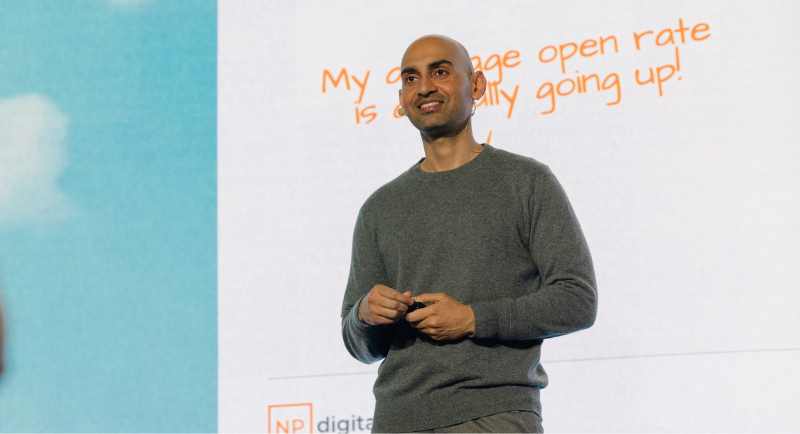Neil Patel, founder of NP Digital, surprised marketers when he explained how regularly scrubbing their mailing list of inactive subscribers improves deliverability and revenue.
“It’s one of the most important things people don’t do because they want this vanity metric of their email list continuing to get larger and larger,” he told attendees of Intuit Mailchimp’s FWD: Sydney conference on Wednesday as part of his presentation on the 10 rules on getting people to open your emails and make them convert.
The presentation championed email marketing as the MVP as engagement across marketing channels such as social media, Google organic clicks and Google ads CTR drop.
“The average open rate drops to 20.54% when an email list contains 6 to 10% disengaged subscribers. It [open rate] goes down to 15.22% when an email list has 11–15% inactive subscribers.
“You need to continuously optimise and scrub your list,” he reiterated.
In an interview with Mediaweek, Patel acknowledged that while most marketers don’t want to take that risk, the before and after results are noticeably better.
“Even if you scrub a very small sample size and instead of removing and deleting the emails, we’re just not going to email them and let’s see what happens, you start noticing your overall campaign results are better.
“I‘m not talking about open rate percentages, but the total number of opens and clicks starts getting better, and then people are much more open to it.
“When you scrub your list, you don’t have to delete them. You could eventually delete them, but in the short run, you can decide whatever you want to do with those lists because you can keep them there and just put them in a different segmentation.”
He shared that marketers who have taken this route have had great results and from there his agency, NP Digital, analyses the emails that drive revenue, loyalty and the brand’s name.
“We start looking at what’s working and what’s not working. Instead of stopping the stuff that’s not working, we try to understand why, dissect it and then try to improve it before changing how many emails are sent out and the types of emails that are sent out.”
Later in the presentation, Patel emphasised the importance of data-driven decision-making, particularly through A/B testing in email campaigns. While many marketers shy away from it due to the extra workload, he stressed the valuable insights it delivers.
“The real benefit of running A/B tests is understanding the copy and the words that resonate more with your audience. You can use that copy, not just in email, but within your ads, your landing pages and other areas of your marketing funnel to boost conversion rates. But if you don’t run A/B tests, you won’t know the type of verbiage and wording and messaging that causes higher conversions.”
The magic of simplicity in a world of chaos
Central to Patel’s email marketing campaigns is simplicity – from direct, no-frills messaging to plain visuals. While marketers have a world of creativity at their fingertips, he noted that some may be getting bogged down by focusing on putting out a visually perfect end product rather than quality content.
“That [a visually perfect end product] doesn’t convert as well as just being real and authentic and being more raw and unedited versus spending too much money producing the FIFA World Cup-type of marketing materials needed.”
In the presentation, he highlighted examples of simple and casual email marketing that was effective but noted that it is not for everyone.
“If you’re Airbus or Boeing selling planes, probably don’t want to be that casual, but it works for majority of the time. When I say majority of the time, +90%, and this is why A/B testing is super important.”
Expanding on the effectiveness of simplicity, Patel noted that people are overwhelmed with options, information and platforms.
“Keeping things simple is a little bit refreshing for a lot of people in today’s world where everything’s chaotic.”
To achieve quality content, he suggested: “Revisions, brainstorming, spending more time getting creative, thinking about what people want that no one’s really talked about or addressed before, and talk about that stuff.
“People want to discuss new things. They want to hear about stuff that isn’t regurgitated. The web is just continually creating a ton of regurgitated content, especially with AI, it’s getting worse.”

Neil Patel: “Keeping things simple is a little bit refreshing for a lot of people in today’s world where everything’s chaotic.”
How email marketing will evolve in the next 12 months
Looking ahead, Patel shared the big trend he sees in the next year is in emails having the purchase function.
“Instead of going to a website, imagine within the email, you can pick the product, the size, the colour and click buy and check out all within that email without leaving Gmail or anything like that. It’s already happening and we’re seeing it more and more.
“Think about that aspect, but for all forms of marketing, how convenient, optimised. You can now buy products directly on Instagram without even going to a landing page. Platforms are making things more convenient and easier for people than ever before.”
While this optimisation has the benefits of being convenient for customers, Patel noted it has the potential to make them feel overwhelmed, push the boundaries of privacy concerns and could be considered “creepy”.
In addition to taking on feedback from customers, Marketers looking to avoid this should “think helpful, not stalker”.
“If your marketing can be helpful, people will love you. If your marketing seems like it’s stalking you, it’s getting too creepy. That’s the easiest way to look at it.”
‘Be where people are’
Patel said he hoped attendees took away the understanding that “marketing is no longer a game of email, social media or SEO.
“Marketing is a game of people’s attention… everywhere.”
He noted that to capture awareness, marketers need to optimise for wherever they are, rather than convince consumers to find them.
“If that means they find your product on social media and just buy on social media without coming to your website, then so be it. Or whether that means you have to have a blog or whether that means that you have to send emails or text messages, you’ve got to leverage all the channels and just be where people are.”
Top image: Neil Patel
